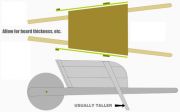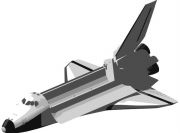|
Evolution in 1-2-3
1) Descent with modification
2) Adaptation and natural selection
3) Speciation
Watching it happen

Imagine an instruction manual for how to build a simple wheelbarrow. Every time we make a copy of the manual a printing error occurs. A letter is misplaced or missing, or a new letter is introduced, garbling the message but not to such an extent that a wheelbarrow cannot be built.
Every new wheelbarrow, with its incredibly tiny and individual "mistake", is tested by the environment in which it must function. Good wheelbarrows are kept whereas faulty or less successfull wheelbarrows are discarded. (Example)
 Over billions of years we make billions of copies of the manual with billions of accumulated typing errors. And ever so slightly, inch by million-year inch, the instruction manual is transformed into a Over billions of years we make billions of copies of the manual with billions of accumulated typing errors. And ever so slightly, inch by million-year inch, the instruction manual is transformed into a
perfect manual for building a space shuttle.
As Richard Dawkins puts it in Climbing Mount Improbable: ”Darwinism is not a theory of random chance. It is a theory of random mutation plus non-random cumulative natural selection. Why, I wonder, is it so hard for even sophisticated scientists to grasp this simple point?”
Maybe it's because one-by-one mutations in base pairs lead to a special kind of genetic garbage: 58% of all such mutations lead to Thymine (T) and 5% lead to Adenine (A). After millions of mutations you would get an abundance of T's in the genetic code and a shortage of A's. So, a one-by-one base pair mutation of the DNA won't get you anywhere.
Or maybe it's because one-by-one mutations of codons won't get you anywhere either: random mutations are more apt to generate certain kinds of amino acids than others. Serine is the result of six different codons (TCT, TCC, TCA, TCG, AGT, AGC), whereas Tryptophan only is the result of one (TGG). Thus, as generation after generation are subject to random mutations at the codon level you would get too much Serine and too little Tryptophan, and the proteins depending on Tryptophan would simply vanish.
Or maybe it's because there are one thousand potentially detrimental mutations for every one mutation which is beneficial. After one thousand generations you have accumulated one thousand errors which garble the instructions and one error which leads to something new and beneficial. After one thousand more generations you have two thousand errors which garble the instructions and one more error which leads to something new and beneficial at that particular point in time. Maybe the sophisticated scientists Dawkins is referring to find it puzzling that this series of events should lead to an improvement of the instruction manual rather than its ultimate destruction. For surely, nature selects among functional wheelbarrows and doesn't read the instruction manuals that produced them, scanning for errors. The sophisticated scientists must think that at some point, the accumulation of potentially detrimental errors at the rate of 1000:1 actually do become detrimental.
And yet, here we are.
The mutations Dawkins is talking about must therefore be something else, like:
- Exon shuffling: a sequence of a gene coding for something else is inserted somewhere else. (Some of the text in the manual describing the wheel is mistakingly added to the section describing the handles).
- Gene duplication: a gene is mistakingly copied so that you get two similar genes which later may evolve in separate ways. (The text in the manual describing the wheel is copied so that you suddenly get two wheels).
- Retropositioning: the gene is read and then written back into the gene somewhere else. (Text describing the wheel suddenly appears among the text describing the handle).
- Mobile elements: codons from somewhere else is adapted into the gene. (A completely new word suddenly appears somewhere in the manual).
- Lateral gene transfer: genes from a different organism is transmitted into the gene. (Text from a spade manual suddenly appears in the wheelbarrow manual).
- Gene fusion: two adjacent genes fuse into a single gene. (Two sentences in the manual become one and is read and understood as one sentence, like "Fixate the wheel use nails for the barrow").
- Gene fission: one gene splits into two. (A sentence in the manual splits into two and is read as two different sentencens, like "Use nails. For the barrow").
- De novo origination: non-coding regions become coding information. (Blank spaces in the manual suddenly become meaningful text).
|